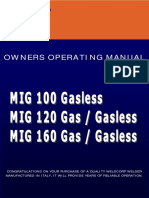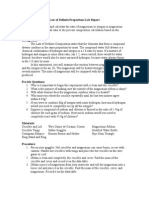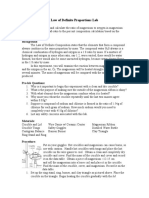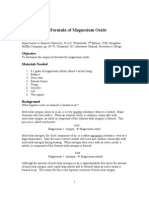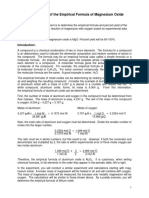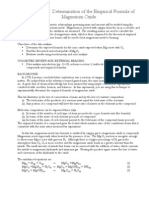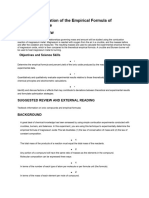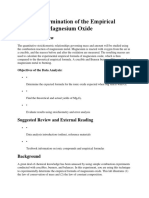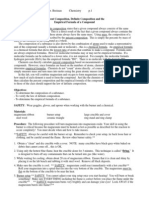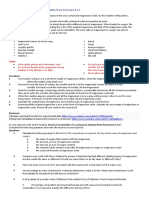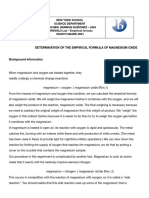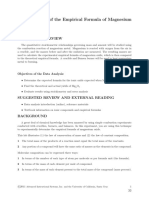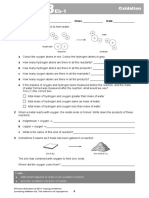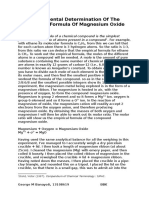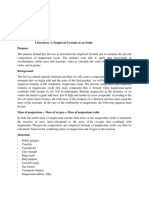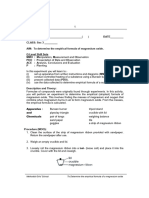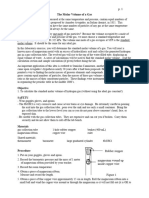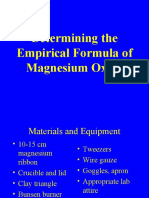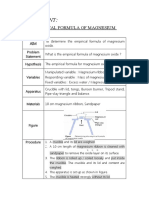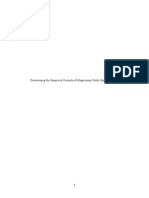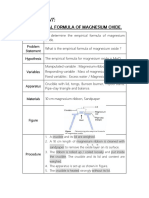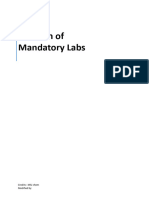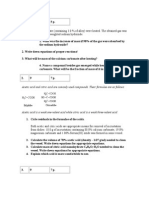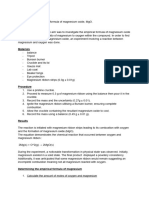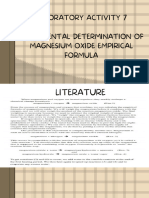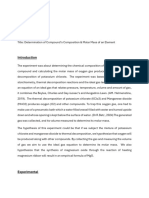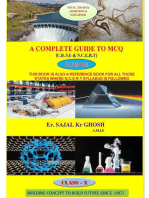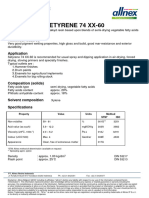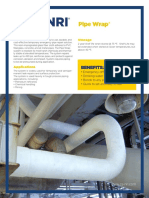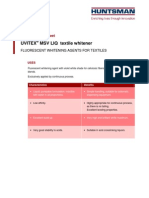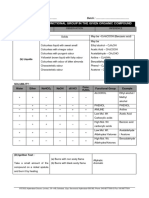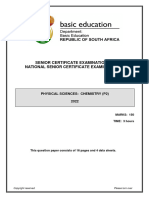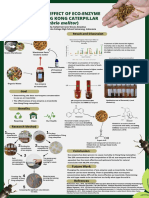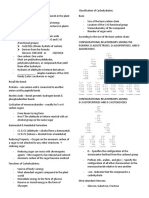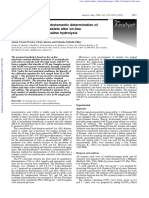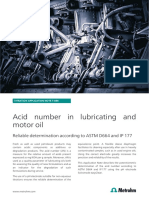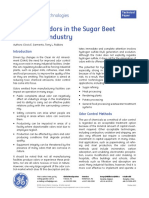0 ratings0% found this document useful (0 votes)
51 viewsExperiment #3 / Unit 3 Determining The Empirical Formula of A Compound (MG O)
Experiment #3 / Unit 3 Determining The Empirical Formula of A Compound (MG O)
Uploaded by
Nurul HamizahThis experiment determines the empirical formula of magnesium oxide (MgO) through synthesis and analysis. Magnesium is burned in air to form MgO, and the masses of the reactants and products are measured. These masses are used to calculate the moles of magnesium and oxygen and their mole ratio in MgO. The mole ratio gives the empirical formula. Possible sources of error are discussed, such as unreacted magnesium, lost product, and impurities in the product.
Copyright:
© All Rights Reserved
Available Formats
Download as DOC, PDF, TXT or read online from Scribd
Experiment #3 / Unit 3 Determining The Empirical Formula of A Compound (MG O)
Experiment #3 / Unit 3 Determining The Empirical Formula of A Compound (MG O)
Uploaded by
Nurul Hamizah0 ratings0% found this document useful (0 votes)
51 views4 pagesThis experiment determines the empirical formula of magnesium oxide (MgO) through synthesis and analysis. Magnesium is burned in air to form MgO, and the masses of the reactants and products are measured. These masses are used to calculate the moles of magnesium and oxygen and their mole ratio in MgO. The mole ratio gives the empirical formula. Possible sources of error are discussed, such as unreacted magnesium, lost product, and impurities in the product.
Original Title
E3.3 Emp. Formula
Copyright
© © All Rights Reserved
Available Formats
DOC, PDF, TXT or read online from Scribd
Share this document
Did you find this document useful?
Is this content inappropriate?
This experiment determines the empirical formula of magnesium oxide (MgO) through synthesis and analysis. Magnesium is burned in air to form MgO, and the masses of the reactants and products are measured. These masses are used to calculate the moles of magnesium and oxygen and their mole ratio in MgO. The mole ratio gives the empirical formula. Possible sources of error are discussed, such as unreacted magnesium, lost product, and impurities in the product.
Copyright:
© All Rights Reserved
Available Formats
Download as DOC, PDF, TXT or read online from Scribd
Download as doc, pdf, or txt
0 ratings0% found this document useful (0 votes)
51 views4 pagesExperiment #3 / Unit 3 Determining The Empirical Formula of A Compound (MG O)
Experiment #3 / Unit 3 Determining The Empirical Formula of A Compound (MG O)
Uploaded by
Nurul HamizahThis experiment determines the empirical formula of magnesium oxide (MgO) through synthesis and analysis. Magnesium is burned in air to form MgO, and the masses of the reactants and products are measured. These masses are used to calculate the moles of magnesium and oxygen and their mole ratio in MgO. The mole ratio gives the empirical formula. Possible sources of error are discussed, such as unreacted magnesium, lost product, and impurities in the product.
Copyright:
© All Rights Reserved
Available Formats
Download as DOC, PDF, TXT or read online from Scribd
Download as doc, pdf, or txt
You are on page 1of 4
Experiment #3 / Unit 3
Determining the Empirical Formula of a Compound (MgxOy)
ntroduction!
In a compound, the atoms are present in whole number ratios as given by
the subscripts. The empirical (simplest) formula of the compound provides that
ratio. For example, the empirical formula for potassium chlorate, Kl!", tells us
that in that compound, for every # K atom there is # l atom and " ! atoms. The
K$l atom ratio is #$#, and the K$! atom ratio is #$". %n important &ob of the
chemist is to find the simplest formulas of any new compounds he or she
discovers. 'cientists are constantly finding new genes, proteins, hormones, etc.
which play important roles in human health and whose complex array of atoms
determine their function.
(mpirical formulas are determined by finding the mass of each element
present in the compound. From these masses one determines the number of
moles (remember, this tells us )how many)) of each element. The mole ratio
mu"t e#ual the atom ratio in the compound so the mole ratio provides us with
the subscripts for the empirical formula.
To find the mass of each element in a compound, one must carry out a
chemical reaction. 'ometimes it is possible to form the compound directly from
the elements. This is called a synthesis reaction. In this experiment, we will form,
or synthesi*e, magnesium oxide by burning magnesium in the oxygen present in
the air.
magnesium + oxygen magnesium oxide (synthesis reaction)
,y measuring the mass of the magnesium before the reaction occurs, and the
magnesium oxide produced by the reaction, one can calculate the mass of
oxygen that reacted with the magnesium. -sing the masses of magnesium and
oxygen in the magnesium oxide we will be able to find the mole ratio between the
elements. The mole ratio will give us the empirical formula of the compound.
$rocedure!
Day 1
#. !btain a piece of magnesium ribbon approximately ./0.1 cm in length.
2agnesium will corrode over time and its surface will become coated with
compounds. 3emove these compounds by rubbing the surface with steel
wool until it is shiny (please do not shine it on the benchtop because it will
remove the gray surface).
4. oil the ribbon around a pencil, but ma5e sure that it will be able to lay flat.
2ass the coil and put it in a labeled cup for overnight storage.
Day 2
#. !btain a clean, dry crucible and lid and record their mass. 6lace the
magnesium coil in the crucible so that it lies flat on the bottom.
*Caution: do not look directly at the burning magnesium. The intense light
may hurt your eyes.
hemistry I ary %cademy 7.8. 3ushin #
4. 7ith the lid off, heat the crucible on a clay triangle set up with a ring stand.
The flame must be a hot one (not necessarily a tall one) and the magnesium
must sit at the top of the pale blue inner cone. 7hen the magnesium ribbon
ignites, you can control the reaction in several ways$
slow down the reaction by covering the crucible to prevent oxygen from
fueling the reaction.
slow down the reaction by partially covering the crucible to control the level
of oxygen.
slow down the reaction by ta5ing away the flame to remove the source of
heat.
speed up the reaction by blowing gently into the reaction to move some
fresh air (and oxygen) to the reaction.
9ote$ if the magnesium burns too :uic5ly, some of the compound will be
vapori*ed (you;ll see white <smo5e=) and lost from the crucible. If you have
trouble getting the magnesium to ignite, try 5eeping the lid on in order to trap
more heat. %fter heating for a few minutes, remove the lid to give the oxygen
access to the hot magnesium.
". >our reaction is complete when you no longer observe the white?orange glow
or spar5s coming from the magnesium. @eat with the lid on for another minute
to ensure a complete reaction. 9ow remove the lid to let in more oxygen. If the
reaction is complete, turn off the burner and allow the crucible to cool.
*Caution: the crucible gets very hot- handle with tongs until it has had several
minutes to cool down.
.. 7hen the crucible is cool, ta5e a stirring rod and %ery gently grind the
contents of the crucible into small particles. 3inse the particles remaining on
the stirring rod and any particles on the sides of the crucible into the bottom
with a minimum amount of water from a dropper. %ll of the solid must come in
contact with water. @eat gently until all the water has evaporated and the
residue is completely dry. %void spattering.
How do know when the com!ound is dry"
Touch it with the glass stirring rod. Is it stic5y or powderyA
The sure way$ heat it until you get a constant mass.
1. %llow the crucible to cool and then mass the crucible, its lid, and the
magnesium oxide. 9ow re0heat and re0mass the crucible.
B. lean and dry the crucible.
Data!
mass of dry crucible and lid
mass of magnesium ribbon
mass of crucible, lid, and compound(s) after first massing
additional massings after reheatings
observations
error log
hemistry I ary %cademy 7.8. 3ushin 4
Calculation" and &ue"tion"!
#. a. alculate the mass of the magnesium oxide produced.
b. alculate the mass of oxygen that reacted with the magnesium sample.
c. @ow many moles of magnesium atoms are there in the compoundA
@ow many moles of oxygen atoms are there in the compoundA
d. 7hat is the mole ratio between the two atoms (show in decimal form to
the correct number of sig figs)A
e. Cetermine how many of each type of atom were present. 7hat is the
ratio between the number of atoms in the compoundA
f. -sing the ratio calculated, what is the empirical or simplest formula
for magnesium oxide (show any rounding and?or multiplying re:uired)A
4. a. -sing the masses of magnesium and magnesium oxide obtained
experimentally, calculate the D2g by mass in magnesium oxide.
b. alculate your percent error from the value obtained in 4a if the
accepted value is B/."ED 2g.
". 7rite electron configurations for magnesium and oxygen before and after the
reaction. (xplain what happened between 2g and ! during the reaction.
.. 7rite e:uations for the formation of the magnesium and oxygen ions.
1. 7rite the e:uation for the reaction of magnesium with oxygen gas to form
magnesium oxide. 'ince oxygen gas is a diatomic molecule, we use its
molecular formula, !4, in chemical e:uations. -se (s) or (g) after the
formulas to identify the substance as a solid or a gas.
B. %ir is a mixture of gases which contains primarily nitrogen and oxygen gases.
7hen magnesium burns in air, a small amount of solid magnesium
nitride, 2g"94, is formed along with the oxide. 9oting that nitrogen gas is
diatomic and has the formula 94, write the balanced chemical e:uation for the
reaction between magnesium and nitrogen gas to form solid magnesium
nitride. Include the physical states of the substances.
F. If water is added to a mixture of magnesium oxide (2gx!y) and magnesium
nitride (2g"94) and heated, the nitride is converted to the oxide . This was
done to ma5e sure we got only magnesium oxide as a product. %mmonia
is produced, leaving the pure magnesium oxide. 7rite the e:uation for the
reaction between magnesium nitride and water. This e:uation does not need
to be balanced. Include the physical states of the substances.
E. Explain the effect on your result for D2g (high, low, or unchanged) if the
following errors had been made (4 pts eachG.must explain for credit)$
a. a small amount of 2g remained unreacted.
b. some of the product was spilled after heating but before ta5ing the mass.
c. all of the water added was not boiled off.
d. the product contained some 2g"94. (tric5y, be careful)
'a( )eport #3*3!
title page
abstract
procedure
data
hemistry I ary %cademy 7.8. 3ushin "
calculations and :uestions
results and discussion (minimum of four errors analy*ed)
hemistry I ary %cademy 7.8. 3ushin .
You might also like
- IB DP Prescribed PracticalsDocument24 pagesIB DP Prescribed PracticalsMitul HariyaniNo ratings yet
- Determining The Empirical Formula of A Compound Lab ReportDocument7 pagesDetermining The Empirical Formula of A Compound Lab ReportSunmi Jin100% (1)
- Empirical Formula of Magnesium OxideDocument7 pagesEmpirical Formula of Magnesium OxideIra Munirah100% (1)
- Formulation of A Biodegradable and Biosynthetic Latex PaintDocument166 pagesFormulation of A Biodegradable and Biosynthetic Latex PaintRose AdelineNo ratings yet
- MIG Operating ManualDocument32 pagesMIG Operating ManualbasaricaNo ratings yet
- Law of Definite Proportions LabDocument3 pagesLaw of Definite Proportions LabJonathan MendarosNo ratings yet
- Magnesium Oxide LabDocument5 pagesMagnesium Oxide LabKartz EswarNo ratings yet
- Law of Definite Proportions Lab: Objective: To Measure and Calculate The Ratio of Magnesium To Oxygen in MagnesiumDocument3 pagesLaw of Definite Proportions Lab: Objective: To Measure and Calculate The Ratio of Magnesium To Oxygen in MagnesiumJhune Dominique GalangNo ratings yet
- 5-Empirical Formula of MgODocument4 pages5-Empirical Formula of MgONaqibah AzmanNo ratings yet
- 1.2 Derivation of EF LabDocument2 pages1.2 Derivation of EF LabbugbbtestNo ratings yet
- Law of Definite Proportions Lab ReportDocument3 pagesLaw of Definite Proportions Lab Reportrinkeanmark50% (2)
- 7-Empirical Formula For MgODocument6 pages7-Empirical Formula For MgOairiel_hamkaNo ratings yet
- Determination of The Empirical Formula 2023Document3 pagesDetermination of The Empirical Formula 2023anikethg2009No ratings yet
- Experiment 2: Determination of The Empirical Formula of Magnesium OxideDocument4 pagesExperiment 2: Determination of The Empirical Formula of Magnesium OxideWaFiy YosHiokaNo ratings yet
- Magnesium LabDocument6 pagesMagnesium Labm6jnprcyq4No ratings yet
- Determination of The Empirical Formula of MgODocument7 pagesDetermination of The Empirical Formula of MgOCicy IrnaNo ratings yet
- Chemistry Formal LabDocument5 pagesChemistry Formal LabRyan HolinsheadNo ratings yet
- MagnesiumOxide LabDocument3 pagesMagnesiumOxide Labwanderlust23100% (1)
- 5.4.1 PRACTICAL Student Copy - Chemicla Composition of A Compound 5.4.1Document1 page5.4.1 PRACTICAL Student Copy - Chemicla Composition of A Compound 5.4.1Declan QuinNo ratings yet
- Determination of The Empirical Formula of Magnesium OxideDocument11 pagesDetermination of The Empirical Formula of Magnesium OxideluciaNo ratings yet
- The Molar Volume of A Gas: Go To TopDocument11 pagesThe Molar Volume of A Gas: Go To TopZu LiyaNo ratings yet
- Prescribed Practicals Lab Manual 2016Document28 pagesPrescribed Practicals Lab Manual 2016rbgrossNo ratings yet
- Empirical formula - magnesium oxideDocument2 pagesEmpirical formula - magnesium oxidetrytobethebest100No ratings yet
- 2019 DP Chemistry Lab ManualDocument23 pages2019 DP Chemistry Lab ManuallzljackieNo ratings yet
- Percentage Composition LabDocument3 pagesPercentage Composition LabriyannjaNo ratings yet
- Lab 6 CHM130LL Empirical Formula of Magnesium Oxide W AnswersDocument3 pagesLab 6 CHM130LL Empirical Formula of Magnesium Oxide W AnswersjsNo ratings yet
- MgO FormulaDocument6 pagesMgO FormulaJayden LauNo ratings yet
- C5a Moles and Empirical Formulae: Relative Formula Mass Calculations - RevisionDocument14 pagesC5a Moles and Empirical Formulae: Relative Formula Mass Calculations - RevisionVishnu SharmaNo ratings yet
- Esws at 8ebDocument8 pagesEsws at 8ebAddy The humanNo ratings yet
- MG ODocument5 pagesMG OGeorge BanayotiNo ratings yet
- Empirical Formula of Oxide LaboratoryDocument3 pagesEmpirical Formula of Oxide LaboratoryAbdelkebir LabyadNo ratings yet
- Lab 12 Empirical Formula of Silver Oxide-2016 VersionDocument9 pagesLab 12 Empirical Formula of Silver Oxide-2016 VersionkawarriorNo ratings yet
- 6 - Copper - Silver and Magnesium ReactionsDocument12 pages6 - Copper - Silver and Magnesium ReactionsMarie Spencer DunnNo ratings yet
- Experiment To Determine The Empirical Formula of MagnesiumDocument3 pagesExperiment To Determine The Empirical Formula of MagnesiumSumaliny SubramaniamNo ratings yet
- IB DP Prescribed PracticalsDocument25 pagesIB DP Prescribed Practicalsgebrunetsanet52No ratings yet
- Screenshot 2024-06-28 at 10.46.30 AMDocument5 pagesScreenshot 2024-06-28 at 10.46.30 AMpolineniyashasviNo ratings yet
- Practicals Lab ManualDocument26 pagesPracticals Lab ManualanthorNo ratings yet
- 1 Determination of The Empirical Formula of Silver Oxide (Flinn AP Lab 1) - Short VersionDocument5 pages1 Determination of The Empirical Formula of Silver Oxide (Flinn AP Lab 1) - Short Versionsohaila ibrahimNo ratings yet
- Lab 12 Empirical Formula of Silver OxideDocument6 pagesLab 12 Empirical Formula of Silver OxideChris GayleNo ratings yet
- Molar Volume GasDocument4 pagesMolar Volume Gasbold bananaNo ratings yet
- MgO Empirical Formula LabDocument27 pagesMgO Empirical Formula LabIvan Hoo Chean YiengNo ratings yet
- Burning Magnesium LabDocument2 pagesBurning Magnesium LabRohan MorarNo ratings yet
- The Empirical Formula of Magnesium OxideDocument3 pagesThe Empirical Formula of Magnesium Oxideみゆ マイクロ100% (3)
- Chemistry Laboratory ReportDocument8 pagesChemistry Laboratory ReportsmyrnaNo ratings yet
- The Empirical Formula of Magnesium OxideDocument3 pagesThe Empirical Formula of Magnesium Oxideみゆ マイクロNo ratings yet
- (Revision) Mandatory LabsDocument30 pages(Revision) Mandatory Labslucas.t.sgpNo ratings yet
- 35th ICHO Prep ProbDocument10 pages35th ICHO Prep ProbchuasioklengNo ratings yet
- Lab report chemDocument3 pagesLab report chemcastejon.emmaNo ratings yet
- Lab Act 7 Magnesium OxideDocument15 pagesLab Act 7 Magnesium Oxidemarygraceangeles0916No ratings yet
- Experiment 5: The Determination of Relative Atomic Mass of MagnesiumDocument2 pagesExperiment 5: The Determination of Relative Atomic Mass of MagnesiumJongFungNo ratings yet
- Chemlab 7 Ionic Compound SynthesisDocument3 pagesChemlab 7 Ionic Compound SynthesisStellie MaxisNo ratings yet
- Determination of An Empirical FormulaDocument8 pagesDetermination of An Empirical FormulaHenry Lee Brewington IINo ratings yet
- Cha 4Document12 pagesCha 4Tun Lin AungNo ratings yet
- Anelisiwe Mbedu 227920406 Prac 04Document5 pagesAnelisiwe Mbedu 227920406 Prac 04yz4xjkw4hgNo ratings yet
- CH 5 Act 6Document7 pagesCH 5 Act 6Chemistry courseNo ratings yet
- A Complete Guide to M.C.Q,Science (C.B.S.E & N.C.E.R.T) Class 10: CBSE MCQ Series, #3From EverandA Complete Guide to M.C.Q,Science (C.B.S.E & N.C.E.R.T) Class 10: CBSE MCQ Series, #3Rating: 3 out of 5 stars3/5 (3)
- The Total Synthesis of Natural ProductsFrom EverandThe Total Synthesis of Natural ProductsJohn ApSimonNo ratings yet
- Super Cool Science and Engineering Activities: with Max Axiom Super ScientistFrom EverandSuper Cool Science and Engineering Activities: with Max Axiom Super ScientistNo ratings yet
- Setyrene 74 XX-60 TdsDocument2 pagesSetyrene 74 XX-60 TdssuryaNo ratings yet
- XI-Chemistry-DOE Support Material 2019-20 - 3Document18 pagesXI-Chemistry-DOE Support Material 2019-20 - 3Samik RaghavNo ratings yet
- BIOCHEM Lec 2 - Water and PH (Dr. Caballes)Document99 pagesBIOCHEM Lec 2 - Water and PH (Dr. Caballes)Thea Cheruve TomentosNo ratings yet
- CSNRI PS PipeWrap EN 25feb20Document2 pagesCSNRI PS PipeWrap EN 25feb20Amel RNo ratings yet
- G9 Chem Paper 4Document7 pagesG9 Chem Paper 4harshvaardhanNo ratings yet
- TDS - Uvitex® MSV LiqDocument6 pagesTDS - Uvitex® MSV LiqAlie ChirNo ratings yet
- CHEMISTRYDocument18 pagesCHEMISTRYEseogheneNo ratings yet
- Functional Group - 2 (New)Document4 pagesFunctional Group - 2 (New)95powerrangersNo ratings yet
- Short QuestionDocument2 pagesShort QuestionRafey TahirNo ratings yet
- Yanmar BulletinsDocument10 pagesYanmar BulletinsBill Carter100% (3)
- Calcium Carbonate As An Agent in Acid Mine Water NeutralizationDocument8 pagesCalcium Carbonate As An Agent in Acid Mine Water NeutralizationAnonymous je3jd2I6No ratings yet
- Roboze ArgoDocument12 pagesRoboze ArgoGregorio PisaneschiNo ratings yet
- Physical Sciences P2 May-June 2022 EngDocument20 pagesPhysical Sciences P2 May-June 2022 EngSimphiwe MpanzaNo ratings yet
- US4336232 - Production of Purified BrineDocument10 pagesUS4336232 - Production of Purified BrineRafael FigueiredoNo ratings yet
- Insecticidal Effect of Eco-Enzyme Against Hong Kong Caterpillar (Tenebrio Molitor) PDFDocument1 pageInsecticidal Effect of Eco-Enzyme Against Hong Kong Caterpillar (Tenebrio Molitor) PDFresearch planNo ratings yet
- CleanserDocument1 pageCleanserDella RosantiNo ratings yet
- Question BankDocument11 pagesQuestion BankRajeev GuptaNo ratings yet
- Investment Casting: Lab Report ME-223 Advance Workshop PracticeDocument2 pagesInvestment Casting: Lab Report ME-223 Advance Workshop PracticeMomina ShakeelNo ratings yet
- Carbohydrates in GeneralDocument6 pagesCarbohydrates in GeneralnnnnNo ratings yet
- Flow Injection Spectrophotometric Determination of Acetylsalicylic Acid in Tablets After On-Line Microwave-Assisted Alkaline HydrolysisDocument5 pagesFlow Injection Spectrophotometric Determination of Acetylsalicylic Acid in Tablets After On-Line Microwave-Assisted Alkaline HydrolysisrteofiloNo ratings yet
- Acid Number in Lubricating and Motor Oil: Reliable Determination According To ASTM D664 and IP 177Document2 pagesAcid Number in Lubricating and Motor Oil: Reliable Determination According To ASTM D664 and IP 177udsaigakfsNo ratings yet
- Control of Odors in The Sugar Beet Processing Industry: Technical PaperDocument7 pagesControl of Odors in The Sugar Beet Processing Industry: Technical PaperIrvan DwikiNo ratings yet
- z3T - Maraging Steel 1-2709 (EOS MS1)Document1 pagez3T - Maraging Steel 1-2709 (EOS MS1)martinm3tNo ratings yet
- Mail Today Pure and Safe?Document7 pagesMail Today Pure and Safe?atharnadim_osNo ratings yet
- UltrafiltrationDocument5 pagesUltrafiltrationYash PatelNo ratings yet
- Quenching and Partitioning SteelDocument18 pagesQuenching and Partitioning SteelUlises Quintana CarhuanchoNo ratings yet
- Coulmometric Methods: Presentation by Farlane Mtisi Fortune Donga Mansfield S.MutyandaDocument40 pagesCoulmometric Methods: Presentation by Farlane Mtisi Fortune Donga Mansfield S.MutyandaIrvinn NhutsNo ratings yet
- d Block Elements Bounce BackDocument112 pagesd Block Elements Bounce Backsurendrakumarbbk47No ratings yet




